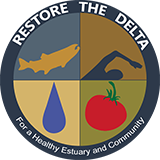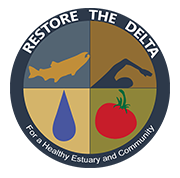For Immediate Release: 2/13/17
Contact:
Barbara Barrigan-Parrilla, 209-479-2053, barbara@restorethedelta.org
Restore the Delta on Oroville Dam Emergency
On the Current Situation
We are hopeful that the Department of Water Resources (DWR) can continue to keep the situation at Oroville under control.
We are grateful for all the courageous and hardworking people working day and night to keep the region safe – from DWR employees to public safety officials.
The evacuations seem to have been successfully executed.
List of evacuation centers
List of shelters
On Oroville Dam
Oroville is the primary reservoir for the State Water Project. One-third of Southern California’s water is State Water Project water. Oroville Dam also is the source for a portion of Bay Area water deliveries. Making Oroville safe is essential and must take priority over any other water project in the state.
This Crisis Was Preventable
The Mercury News is reporting that Federal and State officials ignored warnings 12 years ago. Three environmental groups — the Friends of the River, the Sierra Club and the South Yuba Citizens League — filed a motion with the federal government on Oct. 17, 2005, as part of Oroville Dam’s relicensing process, urging federal officials to require that the dam’s emergency spillway be armored with concrete, rather than remain as an earthen hillside. They warned that the spillway could erode during heavy winter rains and cause a catastrophe.
FERC rejected that request, however, after the state Department of Water Resources, and the State Water Contractors argued that they would likely have had to pay the bill for the upgrades. They said the upgrades were unnecessary. The State Water Contractors & Metropolitan Water District of Southern California’s outsized influenced on DWR to NOT upgrade the emergency spillway is a story that must be thoroughly investigated once the emergency has passed.
Because of this penny pinching, residents of these water districts will lose a significant portion of their water supply for this year. And almost 200,000 lives in the region downstream from the Oroville Dam have been disrupted, physically and economically (with no clear date set for when they can return home). Another series of storms are expected from Thursday through Tuesday of next week.
Millions of Chinook salmon have had to be relocated from the hatchery, with outcomes of disruption to their life cycle to be seen. Swollen rivers filled with debris can have negative impacts on public safety downstream and on wildlife, as levees will experience extreme pressure from emergency flows.
What Should Be Done?
Safety comes first. Before spending a dime on any gold-plated, taxpayer-backed, water delivery service to agricultural interests, we need to upgrade our 678 high hazard dams in California. Making those facilities safe is now the priority over projects such as the Delta Tunnels that will largely serve industrial agricultural interests in the southern San Joaquin Valley.
We need to remind our state water resources agency that they really work for the people of California, not the water districts.
What about the Delta Tunnels?
The Delta Tunnels are only 10% designed, with no seismic analysis, and no full soil samples, yet DWR is leading the charge for state and federal permits for the project.
Are they going to repeat history with the Delta Tunnels and ignore warnings that the design is flawed? As we now see, bad design can have impacts on human health, safety, and the environment.

